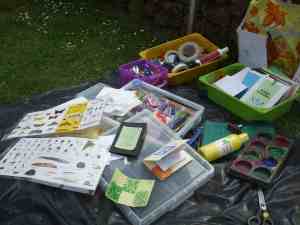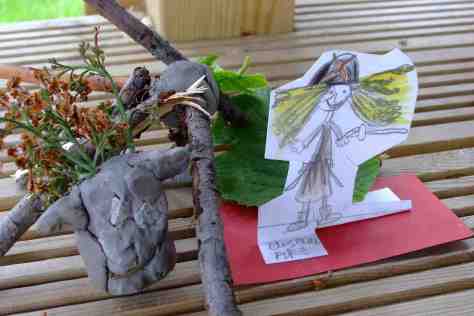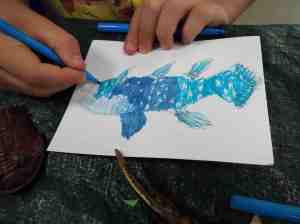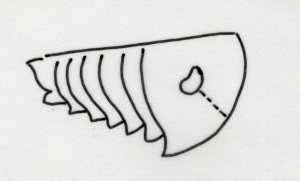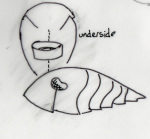Inspired by fossils
Make your own ancient rockpool

A Derwent Stories activity
What might you have found if you had strolled along the beach of an ancient sea a few hudnred million years ago….
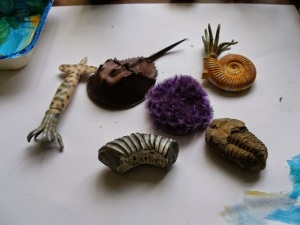
We have used this easy technique many times. We designed it for public events where we would have to make a lot of rockpools with visitors in a short space of time but it is very versatile and you could adapt to suit your situation. While this was set up as a prehistoric event you could of course make a modern rockpool, or perhaps a pond!
We used this activity on our Derwent Stories event at the National Stone Centre
This activity guide uses the materials we used with notes about why we chose this or that
You will need
- a dish – we used waxed card pie dishes (buy in packs from discount stores and supermarkets). Most of our dishes were white but the occasional black ones that we found worked well, too!
- acrylic paint – to paint on the waxed card – we use large bottles but you could get some small tubes, or try mixing some poster or redimix paint with PVA glue and see if that works
- paint brushes or sponges
- Plastic plate to squirt the paint onto (easy to clean)
- small pieces of this card
- coloured pens or pencils
- sharp scissors
- a small stapler (the smaller the better)
- PVA glue
- scraps of stuff: sponge, wool, carrier bag, felt, glitter, sand…..

Thinking about fossils
Our aim was to make a rockpool that you might have found if you could have gone walking along a Carboniferous seashore 300 million years ago. You might want to find pictures of some of the animals of the time to help you. Or maybe you have some fossils to look at? Or some plastic ancient sea creatures? Could you visit your local museum and do some drawings…Perhaps if you printed out this page and waved it at them, they would set up an event for all you ancient rockpoolers?
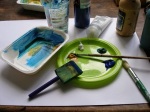
Prepare the pool
Cover your work surface with a sheet of paper – acrylic paint can be hard to clean off. Cover yourself as well if you are a messy worker. You might want an old shirt rather than another sheet of paper
Select your rockpool colours: blue, green turquoise and raw ochre are often good. Smear them round the inside of your pool (paintbrush or painting sponge). You do not need to be too precise here. It is background and more a sense of sand, rock and water that is needed rather than detailed painting
Set to one side to dry

Prepare the wildlife
Ok. Now it’s up to you……

In this pool we have:
- drawings of a trilobite and an ammonite (should we have coloured these in?)
- drawing of a horseshoe crab that has been cut, folded and stapled to give it a more 3-D effect
- drawing of a coral
- fragments of one of my painting sponges have given us some rock
- green wool and a shredded green carrier bag have give us some seaweed
- Fingertip coral: made by wrapping plastercloth round a finger…
Fitting the wildlife
You could glue everything straight onto the dish, or make little brackets to lift things up off the floor and wall a little
Brackets might be small bits of foam or thin strips of card either folded or zig-zagged into a spring

Carefully glue them in place. A matchstick can be helpful in applying glue
Let it all dry, sit back and admire. Then go and tell someone about the day you found a trilobite…..or take and print a photo and send it as a postcard to someone else?
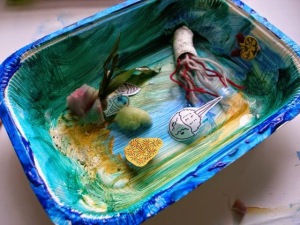
Or send us that photo and we’ll have a gallery of rockpools!







